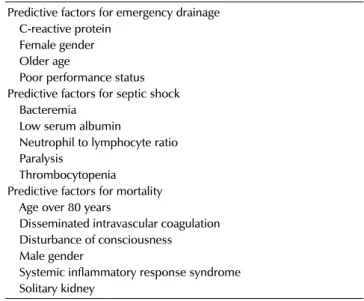Review Urogenit Tract Infect 2016;11(1):12-16
What Are the Predictive Factors of Severe Conditions in Acute Obstructive Pyelonephritis?
Jun Kamei, Yukio Homma
Department of Urology, The University of Tokyo Graduate School of Medicine, Tokyo, Japan
Acute obstructive pyelonephritis is a common urological infection, often requiring emergency drainage, which shows rapid progression to serious conditions, including severe sepsis or septic shock. Therefore, during an initial evaluation, knowledge of factors for prediction of severe conditions or mortality is important for immediate identification of patients requiring intensive care. Previous studies examining the characteristics of patients with acute obstructive or calculous pyelonephritis reported rates of septic shock and mortality of 20.8-33.3% and 0-7.4%, respectively. Thrombocytopenia, older age, low serum albumin, and bacteremia were relatively common predictors for septic shock. In contrast, age over 80 years, systemic inflammatory response syndrome, disseminated intravas- cular coagulation status, disturbance of consciousness, male gender, and having only one kidney were predictive factors for mortality.
Keywords: Pyelonephritis; Sepsis; Septic shock; Ureteral calculi; Ureteral obstruction
Copyright 2016, Korean Association of Urogenital Tract Infection and Inflammation. All rights reserved.
This is an open access article distributed under the terms of the Creative Commons Attribution
Non-Commercial License (http://creativecommons.org/licenses/by-nc/4.0) which permits
unrestricted non-commercial use, distribution, and reproduction in any medium, provided the original work is
properly cited.
Received: 6 March, 2016
Revised: 5 April, 2016
Accepted: 8 April, 2016
Correspondence to: Jun Kamei
http://orcid.org/0000-0002-0069-7392 Department of Urology, The University of Tokyo Graduate School of Medicine, 7-3-1 Hongo, Bunkyo- ku, Tokyo 113-8655, Japan
Tel: +81-3-5800-3815-5411, Fax: +81-3-5800-8917 E-mail: jkamei-tky@umin.ac.jp
INTRODUCTION
Complicated urinary tract infection is defined as infection caused by an anatomical or functional abnormality of the urinary tract. Severe conditions sometimes occur in patients with acute complicated pyelonephritis, and bacteremia has been reported in 20-41% [1,2].
Acute obstructive pyelonephritis is acute pyelonephritis caused by upper urinary tract obstruction associated with ureteral calculi, ureteral structure, or extrinsic compression.
It often shows rapid development into a life-threatening condition such as disseminated intravascular coagulopathy (DIC), multiple organ dysfunction, or septic shock, even with appropriate treatment including anti-microbial therapy, urological intervention, and intensive care [3]. The incidence of sepsis has increased over 30 years, although improved
management has led to decreased mortality associated with sepsis [4,5]. Therefore clarification of factors in acute obstructive pyelonephritis that are predictive of severe conditions and mortality is important for immediate identi- fication of patients requiring intensive care. In the current study, we summarized the recent findings regarding patient characteristics associated with emergency drainage, septic shock, and mortality in acute obstructive pyelonephritis.
METHODS
A systematic literature review was conducted using PubMed and a Urogenital Tract Infection website (http://
www.euti.org/main.html). Terms including “obstructive,”
“pyelonephritis,” “calculi,” and “septic shock” were used
as keywords. Original articles and their references were
